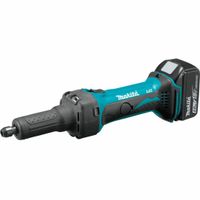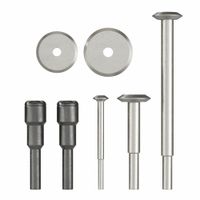Call +(254) 703 030 000 / 751 483 999 / 721 704 777
- Home
- Tools
- Power Tools
- Grinders Cut Off Tools
- Die Grinders
.....Read More
Frequently Asked Questions
What is a die grinder used for?
A die grinder is a versatile handheld power tool used for grinding, sanding, honing, polishing, or machining material, typically metal, but also plastic or wood. It is commonly used in various industries, including metalworking, woodworking, automotive, and construction, due to its ability to perform precision work.
The primary function of a die grinder is to remove excess material from a workpiece, smooth out rough edges, and shape or finish surfaces. It is equipped with a rotating spindle where different attachments, such as grinding stones, burrs, or sanding discs, can be mounted. These attachments allow the die grinder to perform a wide range of tasks, from intricate detailing to heavy material removal.
In metalworking, die grinders are used for deburring, which involves removing sharp edges or burrs from metal parts after cutting or machining. They are also employed for surface preparation, such as cleaning welds or removing rust and corrosion. In woodworking, die grinders can carve intricate designs, smooth out rough surfaces, or hollow out areas in wood pieces.
In the automotive industry, die grinders are used for porting cylinder heads, polishing engine parts, and removing gaskets or adhesives. They are also valuable for bodywork, such as smoothing out dents or preparing surfaces for painting.
Die grinders can be powered by electricity, compressed air, or batteries, with pneumatic (air-powered) models being popular for their lightweight and high-speed capabilities. The tool's compact size and ability to reach tight spaces make it ideal for precision work and detailed craftsmanship.
Overall, a die grinder is an essential tool for professionals and hobbyists alike, offering flexibility and precision for a wide array of applications.
How do you choose the right attachment for a die grinder?
To choose the right attachment for a die grinder, consider the following factors:
1. **Material Type**: Identify the material you will be working on, such as metal, wood, plastic, or stone. Different materials require specific attachments for optimal performance.
2. **Task Requirement**: Determine the task you need to perform, such as grinding, polishing, cutting, or sanding. Each task has specialized attachments like burrs for grinding, sanding discs for smoothing, and cut-off wheels for cutting.
3. **Attachment Material**: Choose the attachment material based on durability and effectiveness. For instance, carbide burrs are ideal for metal, while aluminum oxide sanding discs work well on wood.
4. **Size and Shape**: Select the appropriate size and shape of the attachment to fit the contours and dimensions of the workpiece. Smaller attachments are suitable for detailed work, while larger ones cover more surface area.
5. **Speed Rating**: Ensure the attachment is rated for the die grinder's speed. Using an attachment not rated for the grinder's RPM can lead to breakage or inefficient performance.
6. **Shank Size**: Match the shank size of the attachment to the collet size of the die grinder. Common sizes include 1/4 inch and 1/8 inch.
7. **Brand Compatibility**: Some attachments are designed for specific brands or models. Check compatibility to ensure a secure fit and optimal performance.
8. **Quality and Durability**: Invest in high-quality attachments for longevity and better results. Cheaper options may wear out quickly or provide subpar performance.
9. **Safety Considerations**: Choose attachments with safety features, such as reinforced cut-off wheels, to minimize the risk of accidents.
10. **User Reviews and Recommendations**: Consult user reviews and expert recommendations to gauge the effectiveness and reliability of specific attachments.
What safety precautions should be taken when using a die grinder?
1. **Personal Protective Equipment (PPE):** Wear safety goggles or a face shield to protect your eyes from flying debris. Use hearing protection to guard against noise. Wear gloves to protect your hands and a dust mask or respirator if working with materials that produce dust.
2. **Inspect the Tool:** Before use, check the die grinder for any damage or wear. Ensure that the power cord and plug are intact and that the tool operates smoothly.
3. **Check Accessories:** Ensure that the grinding wheel or attachment is appropriate for the material and securely attached. Inspect for cracks or damage before use.
4. **Secure the Workpiece:** Clamp or secure the workpiece to prevent movement during grinding, which can lead to accidents.
5. **Proper Handling:** Hold the grinder with both hands for better control. Maintain a firm grip and be aware of the tool’s kickback.
6. **Correct Speed and Pressure:** Use the correct speed setting for the material and avoid applying excessive pressure, which can cause the tool to slip or the wheel to shatter.
7. **Work Area Safety:** Keep the work area clean and free of clutter. Ensure adequate lighting and ventilation to avoid inhaling dust or fumes.
8. **Avoid Loose Clothing:** Do not wear loose clothing or jewelry that can get caught in the tool. Tie back long hair.
9. **Disconnect Power:** Always disconnect the power source before changing accessories or performing maintenance.
10. **Follow Manufacturer’s Instructions:** Adhere to the manufacturer’s guidelines for operation and maintenance to ensure safe use.
11. **Stay Alert:** Be aware of your surroundings and stay focused on the task to prevent accidents.
12. **Emergency Preparedness:** Know the location of emergency shut-off switches and first aid kits in case of an accident.
How does a die grinder differ from an angle grinder?
A die grinder and an angle grinder are both handheld power tools used for grinding, cutting, and polishing, but they differ in design, functionality, and applications.
Design: A die grinder is a straight, pen-like tool that is compact and lightweight, making it ideal for precision work. It typically uses a collet to hold various attachments like burrs, bits, and small grinding wheels. An angle grinder, on the other hand, has a larger, heavier design with a right-angle gear head. It uses a disc or wheel mounted on a spindle, which is perpendicular to the motor.
Functionality: Die grinders are primarily used for detailed work, such as engraving, polishing, and deburring. They operate at high speeds, often exceeding 20,000 RPM, allowing for fine control and precision. Angle grinders are more powerful and versatile, suitable for heavy-duty tasks like cutting metal, grinding welds, and removing rust. They operate at lower speeds, typically between 5,000 and 10,000 RPM, but with more torque.
Applications: Die grinders are ideal for intricate tasks in metalworking, woodworking, and automotive industries, where precision is crucial. They are often used in confined spaces and for tasks requiring a delicate touch. Angle grinders are used in construction, metal fabrication, and masonry for cutting, grinding, and polishing larger surfaces. They can handle tougher materials like concrete, metal, and stone.
In summary, die grinders are precision tools for detailed work, while angle grinders are robust tools for heavy-duty applications. Their design, speed, and power make them suitable for different tasks, with die grinders focusing on precision and angle grinders on power and versatility.
What are the advantages of using a cordless die grinder over a corded one?
1. **Portability**: Cordless die grinders offer greater mobility as they are not tethered to a power outlet, allowing users to work in remote or hard-to-reach areas without the need for extension cords.
2. **Convenience**: Without a power cord, users can easily maneuver the tool around the workspace, reducing the risk of tripping hazards and tangling.
3. **Versatility**: Cordless models can be used in various environments, including outdoor and off-site locations, making them ideal for fieldwork and on-the-go applications.
4. **Ease of Use**: The absence of a cord simplifies handling, especially in tight spaces or when working at awkward angles, enhancing user comfort and control.
5. **Safety**: Eliminating the cord reduces the risk of electrical hazards, such as accidental cuts to the cord or exposure to wet conditions, which can lead to electric shock.
6. **Reduced Setup Time**: Cordless grinders require less setup time as there is no need to locate a power source or manage cords, allowing for quicker start-up and increased productivity.
7. **Modern Features**: Many cordless models come with advanced features like variable speed settings, LED lights, and brushless motors, which enhance performance and efficiency.
8. **Battery Technology**: Advances in battery technology have improved the runtime and power output of cordless grinders, making them competitive with corded versions for many tasks.
9. **Noise Reduction**: Cordless grinders often produce less noise compared to their corded counterparts, contributing to a more comfortable working environment.
10. **Flexibility**: Users can easily switch between different tasks and locations without being constrained by the availability of power outlets.
How do you maintain and clean a die grinder?
To maintain and clean a die grinder, follow these steps:
1. **Power Off and Unplug**: Always ensure the die grinder is turned off and unplugged from the power source before beginning any maintenance or cleaning.
2. **Disassemble**: Remove any attachments or accessories. If the grinder has a collet, loosen it to remove the bit.
3. **Clean Exterior**: Use a soft cloth to wipe down the exterior. For stubborn dirt, use a mild detergent solution. Avoid getting water inside the tool.
4. **Inspect and Clean Air Vents**: Check the air vents for dust and debris. Use compressed air to blow out any particles, ensuring the motor remains cool during operation.
5. **Lubricate Moving Parts**: Apply a few drops of machine oil to the moving parts, such as the collet and bearings, to ensure smooth operation. Follow the manufacturer's recommendations for lubrication.
6. **Check and Replace Worn Parts**: Inspect the collet, bearings, and other components for wear and tear. Replace any damaged or worn parts to maintain performance and safety.
7. **Inspect Power Cord**: Check the power cord for any signs of damage or fraying. Replace the cord if necessary to prevent electrical hazards.
8. **Reassemble**: Once cleaning and maintenance are complete, reassemble the die grinder, ensuring all parts are securely fastened.
9. **Test**: Plug in the grinder and perform a test run to ensure it operates smoothly and without unusual noises.
10. **Storage**: Store the die grinder in a clean, dry place to prevent rust and damage.
Regular maintenance and cleaning will extend the life of your die grinder and ensure it operates efficiently and safely.
What are the common applications of die grinders in metalworking?
Die grinders are versatile tools commonly used in metalworking for various applications:
1. **Deburring**: Die grinders are used to remove burrs and sharp edges from metal parts after cutting or machining, ensuring a smooth finish and preventing injury.
2. **Surface Preparation**: They are employed to clean and prepare metal surfaces before welding or painting, removing rust, paint, and other contaminants.
3. **Polishing and Finishing**: Die grinders can polish metal surfaces to achieve a desired finish, using different attachments like polishing pads or wheels.
4. **Grinding and Shaping**: These tools are used to grind down welds, shape metal parts, and refine edges, providing precision and control in detailed work.
5. **Cutting**: With appropriate attachments, die grinders can cut through metal sheets, rods, and other components, offering flexibility in cutting tasks.
6. **Porting and Cylinder Head Work**: In automotive applications, die grinders are used for porting cylinder heads and manifolds, enhancing airflow and engine performance.
7. **Engraving and Detailing**: They are used for engraving designs or details on metal surfaces, allowing for customization and artistic work.
8. **Tool and Die Making**: Die grinders assist in the creation and maintenance of dies and molds, ensuring precision and accuracy in the manufacturing process.
9. **Weld Cleaning**: After welding, die grinders help clean up the weld area, removing slag and smoothing out the weld bead for a clean appearance.
10. **Fabrication and Repair**: In metal fabrication and repair, die grinders are essential for fitting, modifying, and repairing metal parts and structures.
These applications highlight the die grinder's role in enhancing efficiency, precision, and quality in metalworking tasks.


